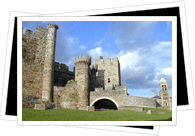
At one point, there were over 10,000 castles documented in Spain! While that number nowadays has been cut down to 2,500, there are endless opportunities to immerse yourself in the mysterious, historical and undeniably romantic aura that surround Spain's castles.
Just why does Spain have so many castles? While many of the Islamic castles and palaces date back much longer, most of Spain's castles were built during the rather lengthy Reconquest, in which the Spain's Christian monarchy little by little took back what the Moors had been ruling for years- up to nearly 900 years in some parts! Constant fighting and fears of retaliation sparked quite the castle-building craze.
The first castles were built along the original line between the reacquired Christian territory and the yet-to-be-conquered Islamic territory. For this reason, the bulk of Spain's castles are found throughout the central regions of Castilla y León and Castilla la Mancha. After all, Castilla - which relates to the world "castillo," or "castle" - isn't called Castilla for nothing!
With the passage of time and the successes of Spain's Reconquest, the border moved further and further south, leaving thousands of castles and fortifications constructed along the way in its wake. Due to their very nature, Spain's castles boast structures and decorations influenced by both medieval Christian and Islamic designs, as seen in elements such as decorative masonry, geometric designs and elaborate battlements.
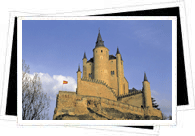
Segovia (Castilla y León)
Widely believed to be the castle that inspired Walt Disney's emblematic Cinderella Castle, Segovia's fairytale Alcázar is complete with conical towers, elegant turrets, peaceful courtyards, an impressive keep and a plunging moat. Built between the 12th and 15th centuries, not only is this castle one of Castilla y León's most prized architectural jewels, but it's also one of Spain's most revered UNESCO World Heritage sites.
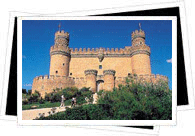
Manzanares el Real (Comunidad de Madrid)
This stunning 15th century castle is not only the symbol of one of the most powerful families - the Mendozas - in Spain's history, but it's also the best-conserved castle in the Comunidad de Madrid. Plus, it's a movie star! If you've ever seen the classic movie El Cid with Charlton Heston and Sophia Loren, then this castle - complete with towers, battlements and surrounded by an impressive medieval wall - is sure to have left a lasting impression. Organized around a central courtyard, or "Patio de Armas," this castle and former noble residence is a stunning mix of Romanesque, Gothic and Mudéjar architectural styles
Belmonte (Castilla-La Mancha)
Located just south east of the city of Cuenca, Belmonte's 15th century castle is certainly one of the most aesthetically interesting castles in Spain, due to its irregular shape. The picturesque castle, a beautiful mix of Gothic and Mudéjar architecture, is surrounded by a zig-zagging wall with cylindrical towers and has an interior triangular courtyard.
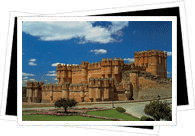
Coca (Castilla y León)
Coca's spectacular fortress was constructed in 1453 by Ávila's bishop- one of the most prominant bishops of the epoch - and looks practically exactly as it did back in the 15th century. With towers and turrets, a heavy Mudéjar decorative influence, a dungeon, an impeccably preserved keep and a 560-meter long moat (considered Castilla's best), the massive castle quickly became the prototype of 15th century manorial castles in Castilla. Every bit as much defensive as aesthetically pleasing, the mixture of Gothic and Mudéjar elements is flawless. Be sure to venture to the "patio de armas" (interior courtyard). With its tiles, elaborate plaster work and double gallery of Corinthian columns, it's the castle's Mudéjar gem.
Medina del Campo (Castilla y León)
Easily one of Spain's most impressive castles, Medina del Campo's castle is also one of the world's best so-called "transition" castles. Designed by Christian Spaniards, the castle was constructed and embellished by Islamic artists over the course of the 13th, 14th and 15th centuries. Featuring a complex of underground compartments, a mixed Romanesque-Mudéjar chapel, a magnificent defensive wall, cylindrical towers and elaborate battlements, the entire castle boasts a distinctively Islamic touch. Like an image straight out of your imagination, there was once a drawbridge that guards had to lower in order to allow people to pass through the monumental tower-flanked entrance.
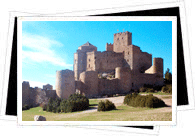
Loarre (Aragón)
Part fortification and part monastery, Loarre's Romanesque castle was built between 1072 and 1080 and is considered to be Spain's most important and best-conserved Romanesque castle. Built in the foothills of the Pyrenees mountains for tactical reasons by Rey Sancho III in the fight against the Moors, it's also credited with sparking the wave of Romanesque architecture in Aragón. With an impressive and architecturally ground-breaking Romanesque chapel, towers, passageways, balconies, arches and some of the best examples of Romanesque decoration, Loarre's castle won't disappoint!